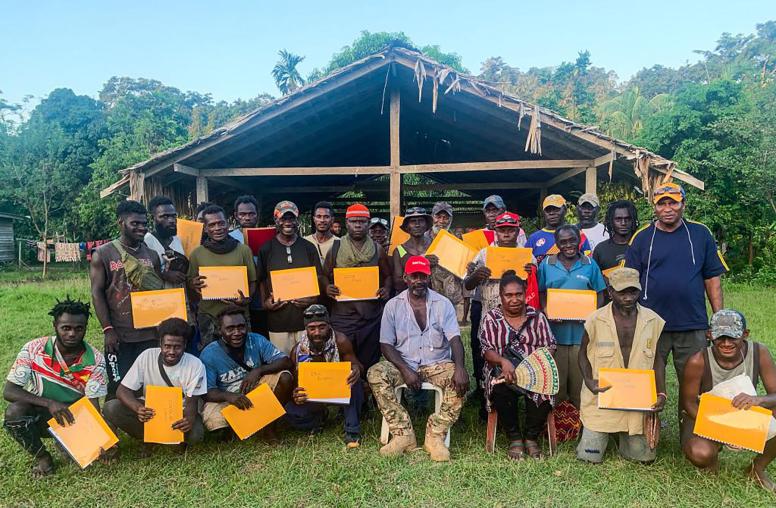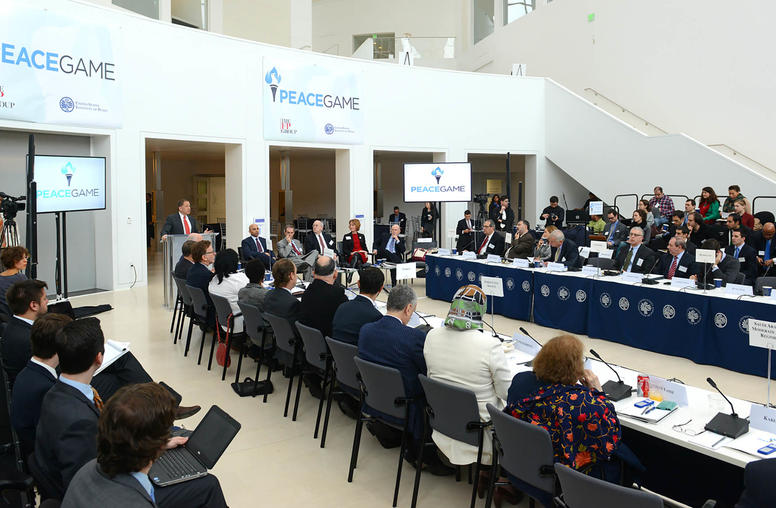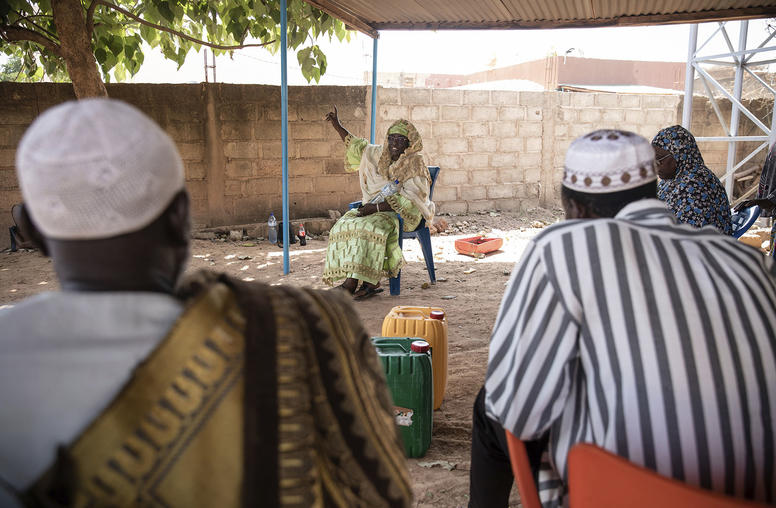Core Conflict Management Resources
An online toolkit for peacemakers, negotiators, and other conflict management practitioners.
- Peacemaker’s Toolkit
In coordination with the United Nations Mediation Support Unit and in collaboration with a number of other mediation institutes and experts, USIP is developing a series of "best practices" handbooks on key aspects of mediation and peacemaking. The series is being designed for experienced mediation practitioners and negotiators, but will be a valuable resource for students and policymakers. Future handbooks include: Assessing and Enhancing Ripeness, Negotiating with Terrorists, Dealing with the Impact of an International Tribunal on a Peace Process; Managing Public Information in a Mediation Process, Debriefing a Mediation Effort, Coordinating Track I and II Efforts, and Addressing Internally Displaced Persons in a Peace Process. Managing a Mediation Process is the first handbook of the Peacemaker’s Toolkit series. This handbook provides a methodology for mediating interstate and intrastate conflicts. Each of the six chapters covers a different step in the process, identifying what needs to be done at that step and how best to accomplish it. By consolidating the practical wisdom of managing a mediation process into an easily digestible format, Managing a Mediation Process is designed to help mediators identify areas where they may need more research or preparation, as well as develop options and strategies relevant to the particular case on which they are working.
Managing a Mediation Process is the first handbook of the Peacemaker’s Toolkit series. This handbook provides a methodology for mediating interstate and intrastate conflicts. Each of the six chapters covers a different step in the process, identifying what needs to be done at that step and how best to accomplish it. By consolidating the practical wisdom of managing a mediation process into an easily digestible format, Managing a Mediation Process is designed to help mediators identify areas where they may need more research or preparation, as well as develop options and strategies relevant to the particular case on which they are working.
 Managing Public Information in a Mediation Process is the second handbook of the Peacemaker’s Toolkit series. This handbook provides those who mediate international conflicts the tools for when they must communicate publicly with a wide variety of audiences, from governments and rebel forces to local and international media, NGOs and IGOs, divided communities, and diasporas. Managing Public Information in a Mediation Process helps mediators identify and develop the resources and strategies they need to reach these audiences. It highlights essential information tasks and functions, discusses key challenges and opportunities, and provides expert guidance on effective approaches.
Managing Public Information in a Mediation Process is the second handbook of the Peacemaker’s Toolkit series. This handbook provides those who mediate international conflicts the tools for when they must communicate publicly with a wide variety of audiences, from governments and rebel forces to local and international media, NGOs and IGOs, divided communities, and diasporas. Managing Public Information in a Mediation Process helps mediators identify and develop the resources and strategies they need to reach these audiences. It highlights essential information tasks and functions, discusses key challenges and opportunities, and provides expert guidance on effective approaches.
- State-Building Competencies
State-building is an increasingly important foreign policy mission, whether in the form of assistance to the developing world or in the form of stability and reconstruction operations in post-conflict societies. This document introduces a set of leadership competencies for state-building professionals (SBPs). It is the culmination of several months of work involving secondary research, input from leaders of international interventions, and discussions with practitioners from the military, civilian agencies, NGOs, and international organizations. The competencies are divided into three categories: core leadership competencies, state-building leadership competencies, and specialized state-building competencies. - Book Series: Culture and Negotiating Behavior
Over the last decade, USIP has produced a definitive series of books on culture and negotiating styles. Described as "profoundly useful," this series is essential reading for diplomats, trade negotiators, policymakers, business leaders, and students. Books have been produced on French, Russian, German, North Korean, Chinese, Japanese, Israeli, Palestinian, and Indian negotiating styles. American, Pakistan, and Iranian negotiating styles are currently under development.
USIP also published Negotiating Across Cultures: International Communication in an Interdependent World (by Raymond Cohen). Orbis describes this resource as "a masterwork of cultural analysis applied to international politics...An insightful and entertaining narrative...on what can, but need not, go wrong in cross-cultural negotiations."
- Field-Defining Textbooks
Institute books serve as the foundation for hundreds of undergraduate and graduate courses in the United States and abroad. Effectively bridging the gap between the academic and practitioner community, USIP texts bring a diverse array of voices to bear, including the perspectives of policymakers, researchers, practitioners, and scholars:- Leashing the Dogs of War: Conflict Management in a Divided World
This definitive volume on the sources of contemporary conflict and the array of possible responses won a 2007 Outstanding Academic Title Award by CHOICE. It is a "must read" not only for students of international relations and conflict resolution but also for anyone—in government and outside—seeking to understand the dynamics of contemporary conflict and the best means of resolving it. - Building Peace: Sustainable Reconciliation in Divided Societies
This book combines wisdom, insight, and passion to explain why we need to move beyond "traditional" diplomacy, which often emphasizes top-level leaders and short-term objectives, toward a holistic approach that stresses the multiplicity of peacemakers, long-term perspectives, and the need to create an infrastructure that empowers resources within a society. "For those who are serious about peacebuilding, this book is simply indispensable" (International Journal). - Peacemaking in International Conflict: Methods and Techniques
This updated and expanded edition describes a number of peacebuilding tools and critically assesses their usefulness. Some of the field's preeminent researchers and practitioners present not only the more traditional approaches to peacebuilding (bargaining and negotiation, third-party mediation, arbitration, and adjudication) but also newer, "nonofficial" approaches that have attracted considerable attention for their innovativeness. "This book is an invaluable addition to the library of those whose careers will expose them to the conflict resolution process" (Naval War College Review).
- Leashing the Dogs of War: Conflict Management in a Divided World
- The Diplomat's Dictionary
Diplomacy means very different things to different people. In this entertaining and informative collection, the author brings together keen observations, witty insights, shrewd advice, and classic words of wisdom on the art and practice of diplomacy. In so doing, this wide-ranging compendium draws on many cultures, ancient and modern. - Guidelines for Relations Between US Armed Forces and Non-Governmental Humanitarian Organizations in Potentially Hostile Environments
Developed in concert with the Department of Defense and Interaction (the umbrella organization for major American humanitarian non-governmental organizations), these guidelines address how the US military and US non-governmental organizations should behave towards each other in non-permissive environments like those in Iraq and Afghanistan. - Guide for Participants in Peace, Stability, and Relief Operations
The Guide is a "one-stop shop" for information on International Organizations (IOs), Non-Governmental Organizations (NGOs), and U.S. military and civilian organizations involved in peacebuilding operations. It is organized to make information readily accessible, incorporates a number of illustrative scenarios, and includes concise descriptions of institutional roles and cultures. It is formatted to fit easily into a pocket or backpack. Extensive involvement by a Steering Committee representing all the communities covered ensures that the information is reliable and up-to-date. - Culture and Conflict Resolution
This highly acclaimed book explores divergent theories of social conflict and differing strategies that shape the conduct of diplomacy, and examines the role that culture has (and has not) played in conflict resolution. In a lively style, the author challenges both scholars and practitioners not only to develop a clearer understanding of what culture is, but also to take that understanding and incorporate it into more effective conflict resolution processes. - Additional Resources
The Institute has been instrumental in helping seed the peacebuilding field, both intellectually and institutionally. Over the course of its relatively short history, USIP has produced over 400 field-defining publications on conflict management. Click here for access to our full inventory of publications. USIP also has an extensive library. Click here to search our print and digital collections of books, periodicals, audio-visual materials, digital files (documents, audio, and video presentations), and more. - Training & Education Resources
The tools described above are valuable assets, but the most important peacebuilding assets are the individuals who engage in it. International peacebuilding (aka, international conflict management) is a relatively new area of systematic study and USIP is making a significant investment in developing relevant materials and courses. Click here to learn more about our Education and Training Center and to access useful materials for the classroom.



